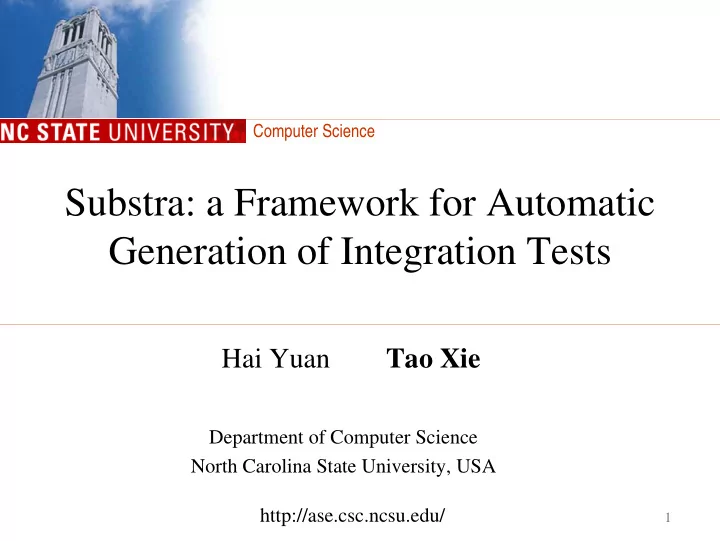

Computer Science Substra: a Framework for Automatic Generation of Integration Tests Hai Yuan Tao Xie Department of Computer Science North Carolina State University, USA •http://ase.csc.ncsu.edu/ 1
Motivation • Software components interact with each other through component interfaces – Integration testing to verify correctness of component interactions • Specifications can help integration testing: test-input generation and behavior checking – But specifications often don’t exist in practice Substra: automatic integration-test generation based on dynamic inference Computer Science 2
Example: ATM Integration Tests ATM thisATM = new ATM (42, "NCSU","Wachovia", null ); Session thisSession = new Session (thisATM); Card thisCard = new Card (1); Transaction thisTrans = Transaction .makeTransaction(thisATM, thisSession, thisCard, 42, 0); thisTrans.performTransaction(); • def-use constraints Computer Science 3 • sequencing constraints
New Approach • Infer specification-like constraints , e.g., def-use constraints sequencing constraints on a subsystem interface from existing runs , e.g., manually written (system/integration) tests normal operations • Generate new tests based on inferred constraints – abstract away primitive method arguments Computer Science 4
5 Substra Framework Computer Science
Trace Collection • Inputs: initial tests/normal operations • Outputs: execution traces • Developed based on Daikon Java front-end [Ernst et al. 01] – Collect states at method entries and exits – State of an object: values of fields transitively reachable from the object Computer Science 6
7 Substra Framework Computer Science
Subsystem Delimitation • Inputs: execution traces + user-defined scope of subsystem e.g., a package or several classes • Outputs: delimited traces • Boundary method call – a method call within the subsystem scope – whose caller is not within the subsystem scope Computer Science 8
9 Substra Framework Computer Science
Def-Use Inference • Inputs: delimited traces • Outputs: def-use constraints • Keep track of each boundary method call info – reference of return object (def) – reference of method-argument object (use) – reference of receiver object (use) • Use object-reference equivalence to infer def-use constraints – stored as guard condition for the method call Computer Science 10
11 Substra Framework Computer Science
Object State Machine (OSM) Construction • Inputs: delimited traces • Outputs: OSMs • OSM – States: receiver object states – Transitions: method calls Computer Science 12
13 Substra Framework Computer Science
Subsystem-State Machine (SSM) Construction • Inputs: OSMs • Outputs: SSMs • SSM – States: subsystem object states • Aggregated object states since the program start • Exclude temp object (created inside a boundary method call c but never referred to after c ) – Transitions: boundary method calls • annotated with def-use constraints as guard conditions Computer Science 14
15 Substra Framework Computer Science
Test Generation • Inputs: SSMs equipped with def-use constraints • Outputs: new tests • Abstract primitive arguments in transitions • Depth-first traverse SSMs to generate method- sequence skeletons • Use jCUTE [Sen&Agha 06] or random techniques to generate primitive arguments in method-sequence skeletons Computer Science 16
Preliminary Results– ATM Example • Originally developed by Bjork; include 4 packages: banking, simulation, atm.physical, atm.transaction • Subsystem scope: atm.transaction • Initial test: withdrawal from an existing account with a correct ATM card number and PIN. http://courses.knox.edu/cs292/ATMExample/Intro.html Computer Science 17
SSM w/ Def-Use – ATM Example Tr6:makeTrasaction arg0=ret ATM.ATM(…); arg1=ret Card.Card(…); arg2=ret PIN.PIN(…); arg3=ret TType.TType(…); Tr7:performTrasaction caller=ret makeTrasaction; Computer Science 18
New Generated Tests – ATM Example • Random test generation for primitive values (also allow user-defined primitive values optionally) • New program behavior exercised by new tests – withdrawal with incorrect account information – deposit with incorrect account information – transfer with incorrect account information – incorrect transaction types – incorrect account types – … Computer Science 19
Related Work • Unit-test generation based on inferred specification [Xie&Notkin 03][Pacheco&Ernst 05] • Infer protocol specifications from program executions [Whaley et al. 02][Ammons et al. 02] • Reverse engineer UML sequence diagrams statically [Rountev et al. 05] or dynamically [Briand et al. 04] • Integration test generation from UML diagrams [Ali et al. 05][Basanieri et al. 02]… • Automatic test factoring [Saff et al. 05] and selective capture&replay [Orso&Kennedy 05] Computer Science 20
Conclusion • Specifications can help integration testing: test-input generation and behavior checking – But specifications often don’t exist in practice • Substra infers integration constraints from existing runs – Def-use constraints – Sequencing constraints • Generate new tests based on inferred constraints – Abstract away primitive method arguments • New tests can expose new useful program behavior Computer Science 21
22 Questions? Computer Science
Recommend
More recommend